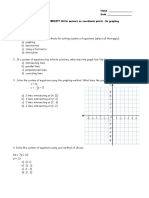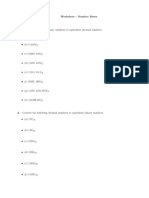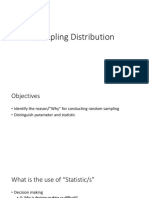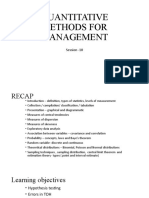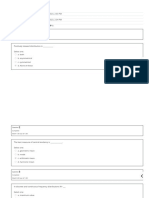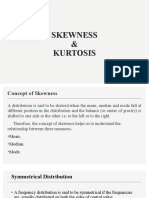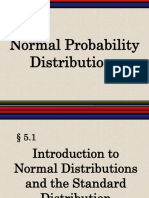Hypothesis Testing Key Words
Hypothesis Testing Key Words
Uploaded by
Subaashini MohanasundaramCopyright:
Available Formats
Hypothesis Testing Key Words
Hypothesis Testing Key Words
Uploaded by
Subaashini MohanasundaramCopyright
Available Formats
Share this document
Did you find this document useful?
Is this content inappropriate?
Copyright:
Available Formats
Hypothesis Testing Key Words
Hypothesis Testing Key Words
Uploaded by
Subaashini MohanasundaramCopyright:
Available Formats
KEY WORDS FOR HYPOTHESIS TESTING
1. Null Hypothesis ( H0 )
- An assertion that a parameter in a statistical mode takes a particular value and is assumed true until
experimental evidence suggests otherwise.
2. Alternative Hypothesis ( H1 )
- Expresses the way in which the value of a parameter may deviate from the specified in the null hypothesis, and
is assumed true when the experimental evidence suggests that the null hypothesis is false.
3. Type 1 error - Rejecting the null hypothesis when it is in fact true.
4. Type 2 error - Not rejecting the null hypothesis when it is in fact, false.
5. Test Statistics
- A function of a sample of observations which provides a basis for testing the validity of the null hypothesis.
relevant statistic hypothesized parameter
test statistics
s tan dard error of relevant statistics
6. Critical Region
- The null hypothesis is rejected when a calculated value of the test statistic lies within this region.
7. Critical Value - The value which determines the boundary of the critical region.
8. Level of Confidence ( example : 95% = 0.95 / 99% = 0.99 )
- How confident are we in our decision.
9. Significance level ( )
- The size of the critical region, the probability of rejection H0 when H0 is true ( Type 1 error).
- Can be calculated - = 1 - level of confidence ( example = 1 - 0.95 = 0.05 )
10. One-tailed test
- The critical region is located at one end of the sampling distribution of test statistic.
- H1 involves < or > but bot both.
Right Tail Test Left Tail Test
11. Two-tailed Test
- The critical region comprises areas at both ends of the sampling distribution of the test statistic.
- H1 involves
Two-tailed test
12. Possible Outcome of a Hypothesis Test
- Reject H0
- Do not reject H0 or Fail to reject H0
13. Conclusion
- Reject H0
Reject H0 as there is sufficient evidence, at ___ % significance level, that the _____details from the
question____.
- Do not reject H0 or Fail to reject H0
Do not reject H0 as there is insufficient evidence, at ___ % significance level, that the _____details from the
question____.
Other important details :
The larger the sample size, the larger the value of test statistics. Therefore the stronger evidence to reject H0.
Steps to do Hypothesis Testing :
1. Define a random variable.
2. State the distribution.
3. State the null and alternative hypotheses.
4. State the significance level.
5. Determine the critical region.
6. Calculate the test statistic.
7. Compare the result.
8. Make decision.
9. Write the conclusion.
You might also like
- MATH 221 Final Exam Statistics For DecisionDocument8 pagesMATH 221 Final Exam Statistics For DecisiongeorgettashipleyNo ratings yet
- Hypothesis TestingDocument60 pagesHypothesis TestingRobiNo ratings yet
- ICS141: Discrete Mathematics For Computer Science IDocument22 pagesICS141: Discrete Mathematics For Computer Science IMahmoud Abdel-SalamNo ratings yet
- LogicDocument39 pagesLogicQuốc Việt ĐỗNo ratings yet
- Hypoth. TestingDocument35 pagesHypoth. TestingRobert Manea100% (1)
- Core - 11 - Statistics-and-Probability - q4 - CLAS1 - Hypothesis - Testing - v1.2 - JOSEPH AURELLODocument12 pagesCore - 11 - Statistics-and-Probability - q4 - CLAS1 - Hypothesis - Testing - v1.2 - JOSEPH AURELLOelementalgamer276No ratings yet
- MethodsofDatacollectionDocument49 pagesMethodsofDatacollectionNadir SherNo ratings yet
- Quiz 1 Basic CalculusDocument6 pagesQuiz 1 Basic CalculusAna-lee LezadaNo ratings yet
- ANOVADocument15 pagesANOVAStocknEarnNo ratings yet
- Lesson: Measure of ShapesDocument16 pagesLesson: Measure of ShapesSheena Opanes SantosNo ratings yet
- Discrete Mathematics Assignment - Quantifiers Inference SetsDocument3 pagesDiscrete Mathematics Assignment - Quantifiers Inference SetsLiezel Lopega100% (1)
- Basiccalculus q1 Module1 Week1Document14 pagesBasiccalculus q1 Module1 Week1Licht Van SchwartzNo ratings yet
- Discrete Mathematics Questions and AnswersDocument27 pagesDiscrete Mathematics Questions and AnswersSuman DasNo ratings yet
- Chapter 2part1Document74 pagesChapter 2part1Waikin YongNo ratings yet
- Chapter 1 Basic Definitions of Stochastic Process, Kolmogorov Consistency Theorem (Lecture On 01-05-2021) - STAT 243 - Stochastic ProcessDocument5 pagesChapter 1 Basic Definitions of Stochastic Process, Kolmogorov Consistency Theorem (Lecture On 01-05-2021) - STAT 243 - Stochastic ProcessProf. Madya Dr. Umar Yusuf MadakiNo ratings yet
- Normal DistributionDocument37 pagesNormal DistributionDia CoraldeNo ratings yet
- Statistics and Probability: Quarter 4 - Module 2Document12 pagesStatistics and Probability: Quarter 4 - Module 2Christian Joseph YuragNo ratings yet
- Rational Function IntroductionDocument23 pagesRational Function IntroductionUddin NimatNo ratings yet
- Null HypothesisDocument10 pagesNull HypothesisarmailgmNo ratings yet
- Derivative Summative AssessmentDocument1 pageDerivative Summative Assessmentapi-479879192No ratings yet
- Lesson 5 The Normal Distribution and Its PropertiesDocument19 pagesLesson 5 The Normal Distribution and Its Propertiessherdan genistonNo ratings yet
- Stat 138 Course SyllabusDocument4 pagesStat 138 Course SyllabusJed SantosNo ratings yet
- Uniformly Most Powerful (UMP) TestDocument2 pagesUniformly Most Powerful (UMP) TestChi Hua WangNo ratings yet
- Random Variables and Probability Distributions Topic 2Document2 pagesRandom Variables and Probability Distributions Topic 2Lhyn Déê100% (1)
- Systems of Equations Assessment REVIEWDocument5 pagesSystems of Equations Assessment REVIEWdevikaNo ratings yet
- Base WorksheetDocument4 pagesBase WorksheetNicola StephensNo ratings yet
- Lesson: Identifying The Regions of Areas Under The Normal CurveDocument10 pagesLesson: Identifying The Regions of Areas Under The Normal CurveDories AndalNo ratings yet
- 4 T-TestDocument68 pages4 T-TestEINSTEIN2DNo ratings yet
- Binomial TestDocument22 pagesBinomial TestJayram JavierNo ratings yet
- Definition of de Morgan's LawDocument4 pagesDefinition of de Morgan's LawSaad ullahNo ratings yet
- Solving Problems Involving Test of Hypothesis On A Population Proportion 4Document16 pagesSolving Problems Involving Test of Hypothesis On A Population Proportion 4Jennelyn JacintoNo ratings yet
- Sampling DistributionDocument37 pagesSampling DistributionJDR JDRNo ratings yet
- CH 02Document53 pagesCH 02markeuNo ratings yet
- Chapter Test - Sampling DistributionDocument1 pageChapter Test - Sampling DistributionJennifer Magango100% (1)
- 7 1 - Area Between Two CurvesDocument2 pages7 1 - Area Between Two Curvesapi-251824010100% (1)
- Sampling & Sampling DistributionsDocument34 pagesSampling & Sampling DistributionsBhagwat BalotNo ratings yet
- Multiple Choice Questions:: A A Xax Xax E EDocument3 pagesMultiple Choice Questions:: A A Xax Xax E ESaketh SentinalNo ratings yet
- Relation and Function 2020Document23 pagesRelation and Function 2020Jaena Perez Ariola100% (1)
- Unit VI Stochastic Processes: Dr. Nita V. Patil Date:27/July/2021Document50 pagesUnit VI Stochastic Processes: Dr. Nita V. Patil Date:27/July/2021abcd0% (1)
- Random SamplingDocument67 pagesRandom SamplingDionisia Rivera Dita100% (1)
- Predicates and QuantifiersDocument30 pagesPredicates and QuantifiersIsagani AlonzoNo ratings yet
- Assignment 1Document5 pagesAssignment 1I can do itNo ratings yet
- Set Theory Exercise 1 2017Document6 pagesSet Theory Exercise 1 2017Desmond KcNo ratings yet
- 1.7 2d Random VariableDocument44 pages1.7 2d Random VariableSHarves AUdiNo ratings yet
- Study Guide 1.1 - Limit of A Function and One-Sided LimitsDocument14 pagesStudy Guide 1.1 - Limit of A Function and One-Sided LimitsEna CharmagneNo ratings yet
- Duc Tran - Mathematical Induction 101 - With 101 Practice ProblemsDocument250 pagesDuc Tran - Mathematical Induction 101 - With 101 Practice ProblemsAhmad ZakiyudinNo ratings yet
- 11 Probability Distribution of Discrete Random VariableDocument8 pages11 Probability Distribution of Discrete Random Variablereneetinonga27No ratings yet
- Derivatives: Differentiation RulesDocument36 pagesDerivatives: Differentiation RulesChristine EvangelistaNo ratings yet
- Math Reviewer For QuizbeeDocument4 pagesMath Reviewer For QuizbeeAdrienne CabanigNo ratings yet
- Mathematical InductionDocument6 pagesMathematical InductionSteve SchouppNo ratings yet
- Testing The Difference Between Two Means, Two Proportions, and Two VariancesDocument21 pagesTesting The Difference Between Two Means, Two Proportions, and Two VariancesAisah ReemNo ratings yet
- Module 1 - Review of Basic ConceptsDocument15 pagesModule 1 - Review of Basic ConceptsMarvin Yebes ArceNo ratings yet
- Uniform Distribution (Continuous) : StatisticsDocument2 pagesUniform Distribution (Continuous) : StatisticsHaider Shah100% (2)
- Descriptive StatisticsDocument42 pagesDescriptive StatisticsLeizza NiguidulaNo ratings yet
- Introduction To Probability 1Document71 pagesIntroduction To Probability 1Venkata Krishna MorthlaNo ratings yet
- Chapter 4 - Continuous Random Variables and Probability DistributionDocument34 pagesChapter 4 - Continuous Random Variables and Probability DistributionĐăng Khoa Đỗ DươngNo ratings yet
- Representation of Data - Frequency DistributionDocument23 pagesRepresentation of Data - Frequency DistributionNihal AhmadNo ratings yet
- Hypothesis TestingDocument8 pagesHypothesis TestingCindy BartolayNo ratings yet
- Quantitative Methods For Management: Session - 10Document95 pagesQuantitative Methods For Management: Session - 10sudheer gottetiNo ratings yet
- Hypothesis TestingDocument58 pagesHypothesis Testingkartikharish100% (1)
- AIML - 21CS54 - IA3 - Preparatory - Question Bank-1Document3 pagesAIML - 21CS54 - IA3 - Preparatory - Question Bank-1seriousviper777No ratings yet
- OlsDocument43 pagesOlsAlina CiabucaNo ratings yet
- Unit 12 - Simple Correlation and RegressionDocument35 pagesUnit 12 - Simple Correlation and RegressionyogeshkadavNo ratings yet
- Statistics AssignmentDocument11 pagesStatistics AssignmentRohit KhatriNo ratings yet
- Checking Data For OutliersDocument8 pagesChecking Data For OutliersKarishma KhoslaNo ratings yet
- Comparison of Minitab and IBM SPSSDocument3 pagesComparison of Minitab and IBM SPSSppdatNo ratings yet
- K00721 - 20200819141744 - SMS1024 Chapter 1 Introduction To StatisticsDocument11 pagesK00721 - 20200819141744 - SMS1024 Chapter 1 Introduction To StatisticsRaajeshwary.TNo ratings yet
- Access Test Bank for Statistics for Psychology 6/E 6th Edition Arthur Aron, Elaine N. Aron, Elliot Coups All Chapters Immediate PDF DownloadDocument37 pagesAccess Test Bank for Statistics for Psychology 6/E 6th Edition Arthur Aron, Elaine N. Aron, Elliot Coups All Chapters Immediate PDF DownloadcorrystadNo ratings yet
- Skewness and KurtosisDocument28 pagesSkewness and KurtosisBlase BashirNo ratings yet
- HO 01 Cost Behavior Determination and PredictionDocument4 pagesHO 01 Cost Behavior Determination and PredictionJOHANNANo ratings yet
- Worksheet On Data Analysis Using JAMOVIDocument5 pagesWorksheet On Data Analysis Using JAMOVIMargie Atalip100% (1)
- GM533 Chapter 6 Study GuideDocument26 pagesGM533 Chapter 6 Study GuideAngel Menchaca0% (1)
- Pnu-Assessment Questions-2Document5 pagesPnu-Assessment Questions-2Rosemarie CunananNo ratings yet
- Hypothesis Testing MCQ (Free PDF) - Objective Question Answer For Hypothesis Testing Quiz - Download Now!Document24 pagesHypothesis Testing MCQ (Free PDF) - Objective Question Answer For Hypothesis Testing Quiz - Download Now!jayant bansalNo ratings yet
- Test1 AnswersDocument7 pagesTest1 Answerstal1997No ratings yet
- Final Report Descriptive Statistics Group 4Document38 pagesFinal Report Descriptive Statistics Group 4QuanNo ratings yet
- EconometricsDocument300 pagesEconometricsmriley@gmail.com100% (4)
- Assignment 2Document2 pagesAssignment 2...No ratings yet
- A Comparison of Different Criteria To Construct Regression Model Employing The Box-Cox and Cole Green TransformationDocument10 pagesA Comparison of Different Criteria To Construct Regression Model Employing The Box-Cox and Cole Green Transformationindex PubNo ratings yet
- Biostatistics 104: Correlational Analysis: YhchanDocument6 pagesBiostatistics 104: Correlational Analysis: YhchandrnareshchauhanNo ratings yet
- Math10 Q4 Week 5-SSLMDocument4 pagesMath10 Q4 Week 5-SSLMJumar MonteroNo ratings yet
- Probability and Statistics: Progress Test 2Document4 pagesProbability and Statistics: Progress Test 2Duy QuangNo ratings yet
- Normal DistributionDocument46 pagesNormal DistributionRain ReevNo ratings yet
- The Estimation of Body Height From Ulna Length in Healthy Adults From Different Ethnic GroupsDocument8 pagesThe Estimation of Body Height From Ulna Length in Healthy Adults From Different Ethnic GroupsRodríguez Brown FrancoNo ratings yet
- Presentation of Regression ResultsDocument5 pagesPresentation of Regression ResultsElizabeth CollinsNo ratings yet
- Module 4Document35 pagesModule 4Nithish kumar RajendranNo ratings yet
- Sta301 Finalterm Mcqs With Reference Solved by ArslanDocument45 pagesSta301 Finalterm Mcqs With Reference Solved by ArslanAbd Ul AahNo ratings yet
- Lecture 14Document21 pagesLecture 14Garvit RajputNo ratings yet
- FDT and MCTDocument19 pagesFDT and MCTJeverlie Vebs TayuponNo ratings yet
- Bowerman Regression CHPT 1Document18 pagesBowerman Regression CHPT 1CharleneKronstedt100% (1)
























